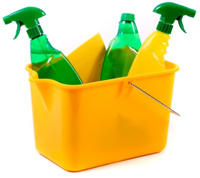Partnerships for Environmental Public Health (PEPH)
Academic Partner:
University of Connecticut School of Medicine/Dentistry
Martin Cheriack, M.D.
Community Partners:
Connecticut Employees Union Independent
Service Employees International Union
Connecticut Council on Occupational Safety and Health
Coalition for a Safe and Healthy Connecticut

Project Description
Researchers from the University of Connecticut School of Medicine/Dentistry collaborated with the Connecticut Employees Union Independent, the Service Employees International Union, the Connecticut Council for Occupational Safety and Health, and the Coalition for a Safe and Healthy Connecticut to improve the acceptance of green cleaning programs among custodians working at state institutions in Connecticut.
The federal government has defined "green" products, more accurately called "environmentally preferable" products (EPPs), as products and methods that "have a lesser or reduced effect on human health and the environment when compared with competing products or services that serve the same purpose."
Traditional cleaning products are associated with both acute and chronic health problems including dermatitis, asthma, and hormonal system (endocrine) disruption. As they work to clean and care for buildings such as schools and offices, custodial workers are exposed to a variety of these chemicals. The formulation of cleaning products is transforming rapidly as new, environmentally preferable chemical ingredients are taking the place of traditional chemicals.
The State of Connecticut mandated the use of EPPs in state facilities, presenting an opportunity for researchers to assess actual exposures, body burdens, and incentives and barriers to wider adoption of safer alternatives.
The project partners:
- Identified barriers and incentives for implementing green cleaning programs and eliminated language and cultural barriers for janitors that may inhibit implementation or use of green cleaning products.
- Conducted a study of associations of traditional and EPP cleaning product exposure with dermal, respiratory, and musculoskeletal symptoms in 329 custodians. It showed fewer negative health symptoms were associated with EPP use.
- Studied how much influence custodians have on the use and effectiveness of chemicals as well as incentives and obstacles for green cleaning programs. This analysis showed that improved communication and feedback among custodians and all stakeholders is needed to make the transition to green cleaning more effective.
The partnership ensured the proper use of green cleaners and disinfectants and helped standardize the adoption of green cleaning products among custodians working at various state institutions. This project culminated in an evaluation of how well this project achieved its aims.
This project was funded by the National Institute for Occupational Safety and Health.
Selected Publications:
- Garza JL, Cavallari JM, Wakai S, Schenck P, Simcox N, Morse T, Meyer JD, Cherniack M. 2015. Traditional and environmentally preferable cleaning product exposure and health symptoms in custodians. Am J Ind Med 58(9):988-995. [Abstract Garza JL, Cavallari JM, Wakai S, Schenck P, Simcox N, Morse T, Meyer JD, Cherniack M. 2015. Traditional and environmentally preferable cleaning product exposure and health symptoms in custodians. Am J Ind Med 58(9):988-995.]
- Cavallari JM, Simcox NJ, Wakai S, Lu C, Garza JL, Cherniack M. 2015. Characterization of Urinary Phthalate Metabolites Among Custodians. Ann Occup Hyg 59(8):982-999. [Abstract Cavallari JM, Simcox NJ, Wakai S, Lu C, Garza JL, Cherniack M. 2015. Characterization of Urinary Phthalate Metabolites Among Custodians. Ann Occup Hyg 59(8):982-999.]
- Simcox N, Wakai S, Welsh L, Westinghouse C, Morse T. 2012. Transitioning from traditional to green cleaners: an analysis of custodian and manager focus groups. New Solut 22(4):449-471. [Abstract Simcox N, Wakai S, Welsh L, Westinghouse C, Morse T. 2012. Transitioning from traditional to green cleaners: an analysis of custodian and manager focus groups. New Solut 22(4):449-471.]


